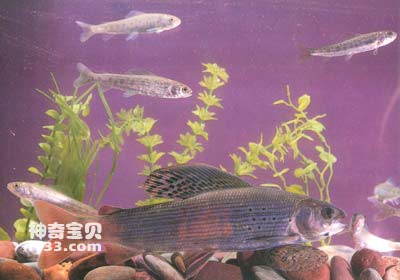Heilongjiang grayling (Thymallus arcticus grubei) belongs to the order Salmoniformes, family Gizzardidae, and genus Thymallus arcticus grubei. Commonly known as: speckled trout, red scale fish, fish flower, sea root. English name: Amur grayling, Arctic grayling.
Endangerment level: Vulnerable.
The body is long and flat on the sides, and the tail stalk is well developed. Muzzle blunt and short. Mouth position, upper and lower jaws are equal in length. Oral cleft tilted. The upper jaw is free and the end can reach below the vertical line in the middle of the eye. Each of the upper and lower jaws has a row of fine teeth, and there are no teeth on the tongue. Big eyes. The scales are small, the lateral line scales are 80-98, and the lateral line is straight. The dorsal fin is long and tall, with a rounded convex dorsal edge and is flag-shaped; the adipose fin is small, located behind and above the starting point of the anal fin; the dorsal fin and anal fin of the female are larger than those of the male. The back and sides of the body are purplish gray, with many small dark brown spots scattered on the sides; the color is obvious during reproduction, with many large red spots on the sides of the adult fish, and each fin is reddish purple. There are two stripes formed by auburn spots on the dorsal fin. In addition to the spots, there are several dark horizontal spots on the side of the body of the juvenile fish, which disappear as it grows. The abdomen is light in color and the whole body is brighter in color.

Heilongjiang grayling is a cold-water fish. It is a typical fish that inhabits mountain streams in the northern cold temperate zone. It has a small swimming range and does not enter rivers and lakes all year round. In summer, they mostly live in the upper reaches of tributaries, and they like to live in rivers with luxuriant aquatic plants, numerous insects, clear water color, and fast currents; in winter, they overwinter in deep water of mountain streams and still eat. Each year there is a short-distance reproduction, a spring migration where the temperature is suitable and the weather is cool, and an autumn migration to escape drought and ice. Grayling feeds mainly on invertebrates and feeds mostly at night. In summer, it likes to hunt aquatic insects and terrestrial insects that fall into the water in shallow water. The mature age is 4 winter years, and the breeding season is from mid-April to early May. At this time, the broodstock swim in groups into the clear and fast water to lay eggs. The eggs often adhere to the gravel on the river bottom.
Heilongjiang grayling is produced in the upper reaches of the Heilongjiang River, the upper reaches of the Nen River, the Mudanjiang River, the Ussuri River, the Songhua River, and the Suifen River; abroad it is distributed along the coast of the Sea of Okhotsk and the Sea of Japan in Russia.
There are two other subspecies of grayling in my country: Yalu River grayling (T.arcticus yaluensis) produced in the Yalu River and Arctic grayling (T.arcticus arcticus) produced in the Irtysh River Basin in Xinjiang. The appearance and appearance of the above three subspecies are similar to The habits are quite similar, only the geographical distribution is different.
Fennel has delicious meat and is a valuable edible fish, but the quantity is not large and there is no certain amount of fishing. Local fishermen mostly fish during the migration period, and the fishing intensity is too high, which significantly reduces the originally small resources. In addition, the construction of reservoirs and water conservancy facilities in rivers has changed the spawning, feeding, and overwintering environment of grayling, which has also affected their reproduction and survival.
animal tags:
We created this article in conjunction with AI technology, then made sure it was fact-checked and edited by a Animals Top editor.